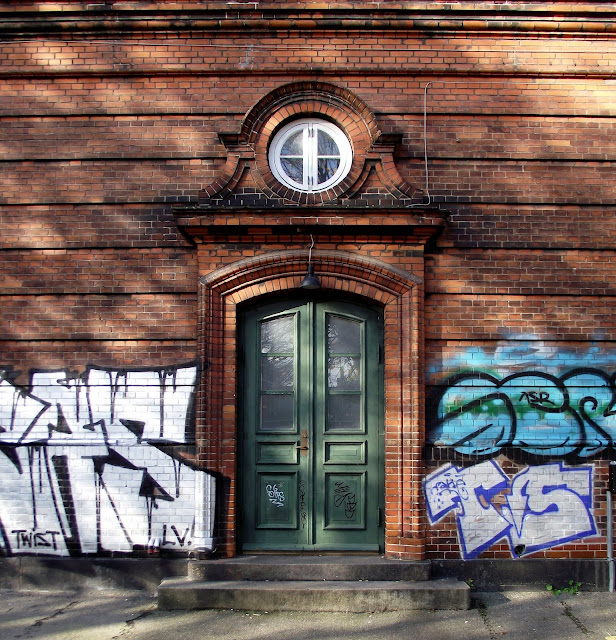Archaeology : Architecture : Art : Cold War : Curiosities : Design : Eccentricities : Ekco : Engineering : Industrial Heritage : Military : Petroliana : Photography : Shed Wonders : Transporter Bridges : Vintage Technology
28 October 2019
Freetown Christiania
Christiania, now covering about 19 acres of the military barracks of Bådsmandsstræd (abandoned from 1967), and remnants of the city ramparts, in the Christianshavn area of Copenhagen, was squatted in 1971.
A mission statement was co-authored by the journalist Jacob Ludvigsen: "The objective of Christiania is to create a self-governing society whereby each and every individual holds themselves responsible over the well-being of the entire community. Our society is to be economically self-sustaining and, as such, our aspiration is to be steadfast in our conviction that psychological and physical destitution can be averted."
The residents developed their own set of rules: no stealing, violence, guns, knives, bullet-proof vests, hard drugs, or bikers' colours. Known also as Freetown Christiania, the commune's cannabis trade was largely tolerated by various Danish governments, some of which saw the area as an interesting social experiment.
Since 1994 the residents have paid taxes for services such as water, electricity and rubbish disposal. The area's open but illegal cannabis trade was ended in 2004, after which outside biker gangs vied to take over the market.
A Christiania resident was killed in April 2005 as a consequence of the resulting violence. The weed trade recommenced, and has operated ever since, other than subsequent to a shooting in 2016 and for a while after police raids.
Since 2010 matters have settled somewhat, and Christiania now operates (largely) under Danish law. Some of the buildings, including the Grey Hall riding house (used as a concert venue), the half-timbered Commander's House, and the 17th and 18th century powder magazines, were listed in 2007 by the National Heritage Agency.
The area was closed to the public by the residents in June 2011, but a year later they set up a collective fund to enable purchase of the land from the defence ministry, making the commune the landowners. No private cars are allowed within the commune, which is currently home to about 900 people.
Labels:
Architecture,
Art,
Eccentricities,
Photography
27 October 2019
Broen / Bron
The Øresund (Danish) or Öresund (Swedish) Bridge is a four-lane motorway and twin-track railway bridge that links Copenhagen and Malmö. The two-deck bridge at the Swedish end of the crossing is 4.9 miles long, and terminates on the artificial island of Peberholm, from where the 2.5 mile Drogden Tunnel runs to Amager, in Denmark. It is Europe's longest combined road and rail bridge. The tunnel was necessary to prevent interference with the flight path for Copenhagen Airport, and to provide a clear passage for ships and ice floes.
The bridge, the principal engineering design of which was undertaken by Ove Arup, was built by a joint venture between Hochtief (Germany), Skanska (Sweden), Højgaard & Schultz (Denmark), and Monberg & Thorsen (Denmark). Construction commenced in 1995 and was completed in August 1999, three months ahead of schedule, at a cost of c.€4bn. The official dedication took place on 1 July 2000. The bridge weighs in at 81,000 tons. The three cable-stayed sections together total 1,611 feet (a third of a mile) in length, and are slung from concrete towers 669 feet high, providing 187 feet of headroom for shipping. Otherwise the bridge is supported on concrete piers spaced at intervals of 459 feet.
Peberholm - Pepper Islet - so-called to partner the nearby natural Saltholm - is built from Swedish rock and the material dredged during construction of the bridge and, in particular, from the trench in which sits the tunnel. The island is 2.5 miles long and averages a third of a mile wide. On the island the train tracks emerge from the lower deck of the bridge and splay out to parallel the vehicular traffic. The Drogden Tunnel comprises 2.2 miles of immersed tube, in twenty concrete sections of 54,000 tons each, 125 feet wide, the largest in the world, plus approach tunnels of 886 feet each. Five side-by-side tubes accommodate two train lines, two lanes of vehicles in either direction, and services and emergency access.
(Photographs by Abi Smith.)
Labels:
Architecture,
Design,
Engineering,
Travel










